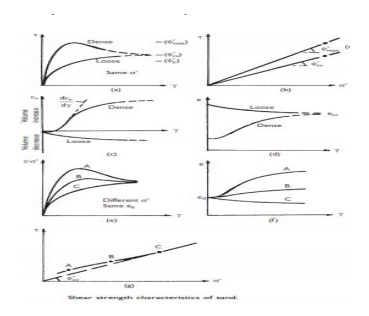Chapter: Civil : Soil Mechanics -Shear strength
Shear Strength Of Sands

Special tests
In
practice, there are verry few problems in which a state of axial sym metry
exists as in the triaxial test. In practica l states of stress the intermediate
principal stress is not usually equal
to the minor
prrincipal stress and the
principal stress directions
can undergo rotation as the failure co ndition is approached. A common
condition is that of plane strain in which the strain in the direction of the
intermediate principal stress is zero due to restraint imposed by vi rtue of
the length of the structure in question. In the triaxial test, consolidation proceed
s under equal all-round pressure (i.e. isotropic consolidation)whereas in-situ
consolidation takes place
under anisotropic stress conditions.
Tests
of a more comple x nature, generally employing adaptions o f triaxial equipment,
have been devised to simulate the more complex states of stress en countered in
practice but these are used
principally in research. The plane strain test uses a prismatic
specimen in which strain in one direction (that of the intermediate principal
stress) is maintained at zero throughout the test by means of two rigid side
plates tied together. The all-round
pressure is the minor
principal stress and the
sum of the applied axial stress and the
all-round pressure the
major principal stress. A more
sophisticated test, also using a
prismatic specimen, enables the values of all three principal stresses to
be controlled independently, two side pressure bags or jacks being used to apply
the intermediate principal stress.
Independent control of the three principal stresses can also be achieved
by means of tests on soil specimens in the form of hollow cylinders in which
different values of external and internal fluid pressure can be applied in
addition to axial stress. Torsion applied to the hollow cylinders results in
the rotation of the principal stress directions. Because of its relative
simplicity it seems likely that the triaxial test will continue to be the main
test for the determination of shear strength characteristics. If considered
necessary, corrections can be applied to the results of triaxial tests to
obtain the characteristics under more complex states of stress.
SHEAR
STRENGTH OF SANDS
The shear
strength characteristics of
a sand can be determined
from the results of either direct
shear tests or drained triaxial tests, only the drained strength
of a sand normally being relevant in practice. The characteristics of
dry and saturated sands are the same, provided there is zero excess pore water
pressure in the case of saturated sands. Typical curves relating shear stress
and shear strain for initially dense and loose sand specimens in direct shear tests are shown in Figure. Similar
curves are obtained relating principal
stress difference and
axial strain in drained
triaxial compression tests.
In
a dense sand there is a considerable degree of interlocking between particles.
Before shear failure can take place, this interlocking must
be overcome in addition to the
frictional resistance at the points of contact.
In general, the degree of interlocking is
greatest in the case
of very dense, well-graded sands consisting
of angular particles. The characteristic stress-strain
curve for an initially dense sand shows a
peak stress at a
relatively low strain and thereafter, as interlocking is Progressively overcome,
the stress decreases with increasing strain. The reduction in the degree
of interlocking produces an
increase in the
volume of the specimen during
shearing as characterized by the relationship,
shown in Figure , between volumetric strain
and shear strain in the direct shear test.
Related Topics